10 Things You Did Not Know about Cataract Surgery
- by Dr. Z Aleksic

- May 3, 2019
- 3 min read
Updated: May 30, 2019
Cataracts might be the most common cause of poor vision today, but here are 10 things you probably did not know about this common ophthalmic surgery.

+ 1. It is much quicker than you would think.
If it is a straightforward cataract surgery, the procedure only takes about 10-15 minutes.
+ 2. You will see a kaleidoscope of images during the surgery.
Patients see only beautiful lights during the surgery because the topical anaesthetic distorts their images, displaying a kaleidoscope of colourful lights.
+ 3. Cataract surgery gets ride of the haze.
Have you ever seen someone endlessly wiping their glasses when their glasses are actually spotless? One of the main indicators of cataracts is that the patient’s lens looks hazy under a microscope. When people look through a cataract they think this haze is on their glasses, when it is actually due to the cataract behind the pupil.
+ 4. Your ophthalmologist will be seated next you the entire time.
One or two hours before the surgery you will be in a pre-operative preparation room where you will get drops in your eye to dilate the pupil. You will then be taken to theatre in a wheelchair. Your face will be cleaned with an anti-septic solution. Your ophthalmologist will be seated next to you and the eye not being operated on will be covered with a drape.
+ 5. You will not have to worry about keeping your eye open
Your ophthalmologist will keep it open with a small speculum. You will also have access to oxygen to prevent feeling claustrophobic.
+ 6. Cataracts cannot ‘grow back’ after surgery.
But, the eye, like all other organs, has a metabolism of its own. Fluid constantly circulates through the eye. What can happen is that protein deposits can start to cling to the lens, giving you the impression that a cataract is developing again. In this case, it appears as if you are looking through that same mist as before the surgery. We can not predict when this will happen. It might take years.
+ 7. These post-surgery protein deposits can be dealt with non-surgically.
It can be treated with a painless, non-surgical procedure, which is not in theatre. You sit in a similar chair as during your examination, with your chin in a chinrest. Your ophthalmologist will then dilate your pupil and shoot the protein deposits off with a YAG laser. You feel as if he is doing nothing and all you can hear is a “tick tick” sound. Your pupil will remain dilated for the rest of the day, so your vision will still be blurry. The next day when your pupil is back to its normal size, your vision will also be back to normal.
+ 8. You can have LASIK after Cataract surgery.
Bear in mind that you need to have a regular corneal shape and enough corneal tissue to correct the remaining refractive error. But this has nothing to do with the cataract surgery and is a factor that all ophthalmologists will consider when determining whether or not a patient is a candidate for LASIK.
+ 9. Cataract surgery is performed on the lens of the eye.
This is surgery which involves going behind the pupil and operating on the lens. The lens should be naturally crystalline, but with age the lens can lose transparency, causing the aforementioned haze.
+ 10. Cataract surgery can also be used for other eye conditions.
Refractive Lens Exchange involves changing the lens due to optical error and not because it is misty. This is the same procedure as cataract surgery. This is not done on ages less than 45 unless you have a cataract as well.




Comments